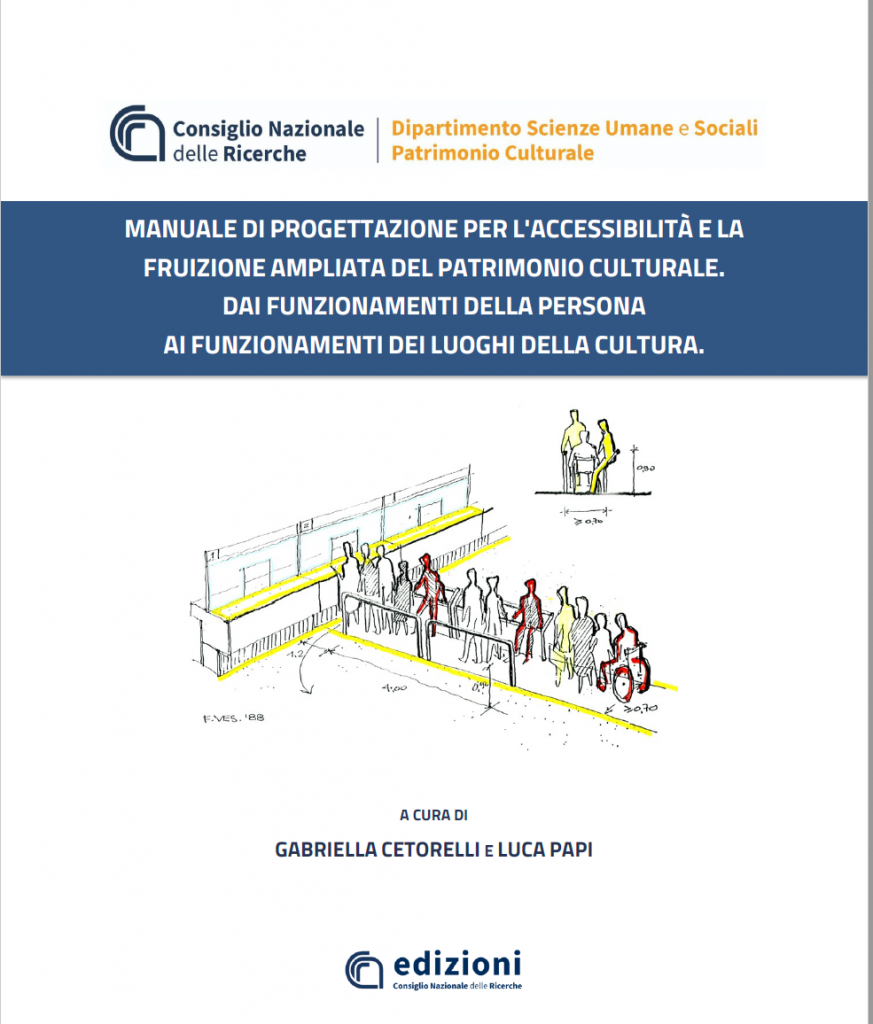Design Manual for Accessibility and Enjoyment of Cultural Heritage. From Human Functioning to the Functioning of Cultural Spaces
CNR, Department of Human and Social Sciences, Cultural Heritage (CNR-Dsu) Edited by Gabriella Cetorelli (MiBACT) and Luca Papi (CNR) CNR Editions, 2024
The Accessibility Project for RAI Cultural Spaces, born from the decade-long collaboration between the two RAI Directorates for ESG Sustainability and CRITS, has become the central focus of RAI’s contribution to the ‘Design Manual for Accessibility and Enjoyment of Cultural Heritage. From Human Functioning to the Functioning of Cultural Spaces’ by CNR, published in February 2024.
https://www.cnr.it/it/new_editoriali
This manual synthesizes key elements of the concept of ‘designing for all’ in cultural contexts, starting with the analysis of various ways individuals function and identifying how inadequate or insufficient social responses can be disabling to specific enjoyment needs. The World Health Organization (WHO) has identified facilitators as factors that can enhance individual functioning, thereby reducing disabilities. This perspective, aligned with the principles of Universal Design, places the human being at the center of an interconnected ecosystem that includes cultural heritage.
In this vision, the functioning of individuals forms the essential foundation for conscious and responsible accessibility design. This is particularly relevant for supporting functional adaptations in response to new needs arising from social complexity, as reflected in the current context.
The narrative incorporates the Rai experience gained from the Accessibility Project for RAI Cultural Spaces, with the two specific contributions of the Avatar LIS Project and the Beethoven Project, designed and developed to promote inclusivity and ensure equitable access to cultural experiences for everyone.
RAI has always played a crucial role in implementing technologies and practices that promote accessibility in the media. Through the use of subtitles, audio descriptions, and other tools, RAI has made it possible for people with sensory disabilities to fully participate in the enjoyment of cultural content, breaking down communication barriers and ensuring broader and more inclusive access.
The Avatar LIS Project, focused on Italian Sign Language (LIS), aimed to eliminate linguistic barriers for signing deaf individuals. Through the creation of LIS avatars, this project allowed more effective communication, enabling deaf individuals to access cultural and artistic information directly and comprehensively. The project’s derived tool, the “Didattica LIS” web platform, demonstrated its effectiveness in schools, leading to the expansion of the LIS dictionary through the work of deaf signing experts and the production of educational aids for deaf students.
The Beethoven Project contributed to making classical music accessible even to those with hearing difficulties. Through the use of innovative technologies, such as magnetic induction and streaming to cochlear implants and hearing aids, the project allowed people with hearing disabilities to fully experience the emotions associated with classical music, transforming the cultural experience into an inclusive and engaging moment. The RAI Toscanini Auditorium in Turin for the magnetic induction system and the Via Asiago Auditorium in Rome for the streaming system thus became accessible cultural venues.
These collaborative projects focused not only on the functioning of individuals, including various sensory abilities, but also on the functioning of cultural spaces. They promoted the design of accessible spaces, the implementation of advanced technologies, and the adoption of inclusive practices to ensure that cultural heritage is accessible to all, regardless of physical or sensory abilities. The Design Manual for Accessibility and Enjoyment of Cultural Heritage greatly benefits from these contributions, offering practical guidelines and innovative solutions to make cultural heritage a shared treasure for every individual.
